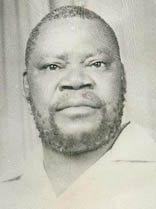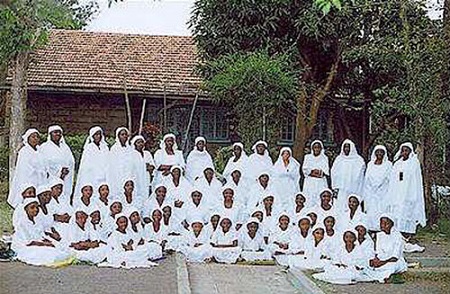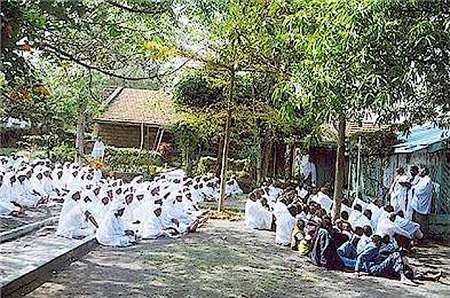Classic DACB Collection
All articles created or submitted in the first twenty years of the project, from 1995 to 2015.Masowe, Johane
 Founder of the Gospel of God Church in Zimbabwe, Johane Masowe had a career remarkably similar to another Shona prophet, Johane Maranke. Both men came from eastern Zimbabwe and both had deep religious experiences in 1932. As a result, both assumed the role of a modern-day John the Baptist by preaching repentance and baptism among African peoples. Both traveled far and wide establishing groups of followers, first in Zimbabwe, then throughout southern, central, and east Africa, and beyond. These groups are collectively known as vaPostori, or Apostles in Shona. They are characterized by their appearance: men shave their heads and grow beards, while women wear white dresses and scarves.
Founder of the Gospel of God Church in Zimbabwe, Johane Masowe had a career remarkably similar to another Shona prophet, Johane Maranke. Both men came from eastern Zimbabwe and both had deep religious experiences in 1932. As a result, both assumed the role of a modern-day John the Baptist by preaching repentance and baptism among African peoples. Both traveled far and wide establishing groups of followers, first in Zimbabwe, then throughout southern, central, and east Africa, and beyond. These groups are collectively known as vaPostori, or Apostles in Shona. They are characterized by their appearance: men shave their heads and grow beards, while women wear white dresses and scarves.
Johane Masowe was born in 1914 or 1915 in Gandanzara village in Makoni district of eastern Zimbabwe, the second of six sons and a daughter born to Jack and Efie Masedza, of the Manyika subgroup of the Shona people. His parents named him Shoniwa Masedza Tandi Moyo [1], but the change of name to Johane Masowe came about through the religious experience that launched him into an itinerant preaching ministry from 1932 until his death in 1973.
Police records from the white colonial regime of Rhodesia (Zimbabwe) indicate that Johane Masowe first got the attention of the authorities when he was arrested in 1932 for traveling around preaching without proper documents. In the police interrogation, he explained that he began having severe pains in the head that culminated in a dream that he had died. After that, he heard voices saying that his name was now John, which he interpreted to mean John the Baptist. This new name carried a mandate to preach to the African people.
His commission came from spending forty days in prayer on Marimba Hill, near the town of Norton, during which time he did not sleep and survived only on wild honey. A voice from a burning bush told him, “I have blessed you. Carry on with the good work. Tell the natives to throw away their witchcraft medicines, not to commit adultery or rape.” After these experiences, his headaches ceased [2].
He told police, “I really do believe that I have been sent from heaven to carry out religious work among the natives. I think that I am ‘John the Baptist,’ as the voice told me so. No human being has guided me in my teachings” [3]. Masowe’s commission, as described in his own words, resembled that of Moses, John the Baptist, and Jesus in spending time alone in the wilderness, hence the name Johane Masowe, meaning “John of the wilderness” [4].
It was no coincidence that Masowe’s and Maranke’s ministries began during the height of colonialism, when Africans were feeling the effects of racial discrimination and the Great Depression. Both men preached in reaction to white domination, promising a better situation for Africans without white influence. While they harkened back to some African traditions, they insisted that other traditions be stopped, thus creating a new kind of religious movement, containing a mixture of both old and new. The vaPostori are a blend of African Traditional Religion and Christianity, with Old Testament practices being prominent. They are good examples of African Initiated Churches.
Masowe had no intention of abiding by colonial restrictions on his movements, but continued to preach and baptize people from his own Shona-speaking group even after he was arrested and imprisoned several more times. Documents surviving from Native Commissioners indicate that the authorities often kept Masowe under surveillance and witnessed how crowds of Africans responded enthusiastically to his preaching by handing over to him their fetishes and charms, along with items dedicated to witchcraft, as well as those used simply for female adornment [5].
Masowe’s message, however, was not only for his own ethnic group, but for all Africans. Pressure from local authorities plus his own missionary zeal soon launched his sect of vaPostori into neighboring groups, even those considered hostile to Shona-speaking peoples. By the end of the 1930s, Masowe moved to Bulawayo, the capital of the Ndebele-speaking people, who are traditional enemies of the Shona-speaking peoples. Despite tribal differences, Masowe became a successful cross-cultural missionary inside Zimbabwe.
Then he launched an international mission, traveling through South Africa in the 1940s, again partly due to pressure from colonial authorities and partly because of his own vision for Africa’s future. Around 1947, he settled in the Korsten district of Port Elizabeth, South Africa, and some of his followers began to migrate there to join him. Realizing that they needed some means of generating income that would not drive them to join the larger society, Masowe initiated the self-help projects in Korsten that became a vaPostori trademark and earned them the name “Korsten Basketmakers” [6].
When the South African authorities discovered that most of the “Korsten Basketmakers” were illegal immigrants, they repatriated 1,880 Masowe vaPostori by train to Zimbabwe in 1962 [7]. Since countries to the north were finally being granted independence from Britain, the vaPostori preferred to move there rather than having to deal with colonial authorities again. Large numbers of them moved to Lusaka, Zambia and to the Zambian Copperbelt. There they discovered some of their own number who had migrated directly from Zimbabwe much earlier [8].
From Zambia, the vaPostori continued to spread throughout central and east Africa. Masowe took up residence in Dar es Salaam, Tanzania in 1964 and later lived in Arusha, Tanzania and Nairobi, Kenya. The vaPostori entered Kenya in 1967, Mozambique in 1969, and Congo (Zaire) in 1972 [9]. After Masowe died in Ndola, Zambia in September 1973, his body was flown home by airplane for burial at his home in Gandanzara, Zimbabwe. By that time the number of Masowe vaPostori exceeded half a million people in nine nations of southern, central, and east Africa [10].
Without foreign help, he raised up a group of disciples from numerous people groups and languages who followed him wholeheartedly. Each disciple was required to change lifestyle drastically and to support the movement totally. While his followers actively spread their new faith, Masowe set the pace by preaching constantly for 41 years. After his death his movement continued to spread both by the high birth rate associated with polygamy, which was approved (Masowe himself had three wives), and by evangelism to win new converts. One estimate put the number of his followers at about one million by the end of the twentieth century [11].
The message that Masowe preached derived from his background in African traditions, his religious experience in 1932, and from his interaction with white Christianity and the Bible. He strongly critiqued both African traditional religion and white Christianity. For instance, he demanded that Africans give up witchcraft and surrender charms and fetishes. He pointed to ancestral sins of Africans and called for repentance because of God’s impending judgment. At the same time, he could not support a religion like the white Christianity that he knew, where Africans were second-class and had to get an education in order to preach or come close to God. He believed in direct revelation from God, as opposed to the mediation of white people or African ancestors.
Johane Masowe initially even rejected the Bible because Africans did not originally have books, so it was the form of God’s word that Masowe objected to. The Bible in book form implied the need for European education and money in order to know what God wants [12]. Masowe felt that God had spoken to him directly and that the God of the Bible was the same as the Shona creator God, Mwari.
When Masowe accepted the Bible, he still objected to how Europeans used it. This was because white missionaries tended to discount the possibility of miracles even though they occurred in the Bible. This was Masowe’s basic objection to white Christianity: it was too academic and therefore failed to touch the Africans’ deepest needs. He preferred to do what people in the Bible did rather than only read about it [13]. This meant supernatural healings, prophetic utterances, exorcisms, and ecstatic worship.
Masowe’s birthplace, Gandanzara, was the location of a key Methodist mission station. In contrast to the periodic camp meetings conducted by missionaries, Masowe offered continual rather than occasional rituals of repentance, exorcism, and protection [14]. What the more enthusiastic white missionaries offered in small doses at camp meetings, Africans wanted in large and continuous doses.
In addition, the vast majority of vaPostori still do not have church buildings, but meet under trees. Originally this was probably part of Masowe doctrine: “Today the name Johane Masowe is associated with communities which pray in open air venues called masowe [wilderness], preach repentance and carry out baptisms in rivers and/or dams called ‘Jordans’” [15]. The lack of buildings does not imply the inability to purchase such structures, as the vaPostori have become quite prosperous relative to their neighbors, but is a reflection of their pilgrimage.
Masowe innovated in worship services also. An example of this is the “Hosanna mukuru” (“Great Hosanna”), held on Saturdays, the vaPostori Sabbath. Generally worship is held outdoors in keeping with the wilderness theme prominent in Masowe’s life and name. Men sit at the front and women and children behind, all dressed in white and barefoot. Time for worship to start is announced when some women dressed in white take their place between the men and women. These are the Sisters, many of whom never marry, as they are devoted to prayer.
A worship leader then shouts, “Imbai!” (“Sing!”) in Shona and everyone sings the words “Hosanna” repeatedly until the song melts into high-volume unison prayer, finally returning to singing, “Hosanna, Hallelujah!” [16]. The singing of the Hosanna transports the vaPostori back to the hill where Masowe first had his vision and heard angels singing Hosanna [17]. Prophets and preachers have time to speak, commenting on Bible passages or reminding participants of their history as a group.
The Sisters are another unusual feature of the vaPostori. Since celibacy is highly unpopular in Africa, an obvious question is how this group of women arose within the Masowe community. One explanation is that Shona spirit mediums sometimes required parents to devote their unmarried daughters to their service. These girls were called “wives of Mwari,” who lived in chastity during the time of their service [18].
When he was in Port Elizabeth, Johane Masowe began to organize the Sisters as a group who accompanied him to pray and sing at gatherings as his spiritual “wives,” but who abstained from sexual relations as an expression of their devotion to God. As it became clear that the vaPostori would have to leave South Africa, the Sisters took on an increasingly symbolic value as the presence of God among them. As Masowe saw himself as a Moses-figure leading his people to the promised land, the Sisters came to resemble the ark of covenant [19]. Thus the Sisters can also be understood in terms of pilgrimage.
Masowe people see themselves as aliens shaped by their early experiences of being harassed by colonial authorities as well as having a message for all of Africa. Thus their missional push can also be described as pilgrimage. Inspired by Masowe, the vaPostori had an urge to reach Nairobi (seen as the center of Africa), Ethiopia (an ancient center of Christianity), and Jerusalem. This stemmed from their call to liberate all of Africa and their view of themselves as “the new African Israelites wandering through many lands as they made their way to the Promised Land” [20].
Because of this steady migration, Masowe and his followers remained a sect that is secretive and suspicious of outsiders. Other Africans see them as different because they stand out. When a person joins their congregation, it means a complete change. The cost of becoming a follower of Masowe is high. Apart from the need to shave the head and grow a beard for men, or to wear white dresses and headscarves for women, the vaPostori are a closed community. The followers of Masowe are not permitted to work for anyone outside their own group. Thus a Masowe disciple is required to learn a trade by which he or she can contribute to the welfare of the group; any other work is unacceptable. This communal work ethic and business acumen have made the vaPostori prosperous.
On the question of the status of Johane Masowe among the vaPostori, some would say that he acted as the Messiah for Africa [21]. Isabel Mukonyora, a fellow insider to Shona culture, disputes this notion. She regards Masowe’s death experience as similar to the suffering of Shona spirit mediums, and hence not equivalent to the death and resurrection of Jesus. “In other words, Johane Masowe merely suffered acutely from his illness before his followers recognized him as a prophet. He did not die and rise again as Christ did to save humankind, only to die again to be buried in Gandanzara some 30 years later” [22]. She says that Masowe saw himself as a prophet like John the Baptist and not as Messiah.
In any case, Masowe’s followers came to regard him as more than a prophet. The current website of the Gospel of God Church in Nairobi, Kenya contains sophisticated arguments to support the notion that Masowe is indeed equivalent to Christ. These explain that Jesus had a limited ministry to the “lost sheep of Israel” (Matthew 15:24) and so could not have fulfilled the prophecy of Isaiah 19:20 that a Savior would come to rescue those oppressed in Egypt. Johane Masowe, however, was sent to liberate Africans. This assertion is backed up with a quote from 1 Enoch 90:38, “That lamb became a great animal and had great black horns on its head and the Lord of the sheep rejoiced over it.” The website article concludes that Masowe himself supplied the interpretation of this passage: “The black horns of the great animal were a pointer to the fact that the last Messiah would come from a Nation of Black people” [23].
The fact that the Masowe vaPostori have developed a website that includes such exegesis is indicative of their commitment to change from a thoroughly African perspective. For instance, the website displays photographs of vaPostori in their white robes on pilgrimages in places like Jerusalem and Axum, an ancient Christian kingdom in Ethiopia. Despite their emphasis on Africa, they continue to make further pilgrimages to such places as Britain, Germany, the United States, and India, on the instructions of Masowe to preach the gospel worldwide. The vaPostori demonstrate that Africans can achieve far more than they and others have expected, building on their own cultural heritage.
Robert Reese
Notes:
-
Clive M. Dillon-Malone, The Korsten Basketmakers: A Study of the Masowe Apostles, an Indigenous African Religious Movement (Manchester, UK: Manchester University Press, 1978), 14.
-
Ibid., 12.
-
Ibid.
-
Ibid., 16.
-
Ibid., 19.
-
Ibid., 29.
-
Ibid., 34.
-
Ibid., 37.
-
Ibid.
-
Isabel Mukonyora, “The Dramatization of Life and Death by Johane Masowe,” Zambezia 25:2 (1998): 193.
-
Ibid., 194.
-
Matthew Engelke, A Problem of Presence: Beyond Scripture in an African Church (Berkeley: University of California Press, 2007), 5.
-
Ibid., 97.
-
Terence Ranger, “‘Taking on the Missionary’s Task’: African Spirituality and the Mission Churches of Manicaland in the 1930s,” Journal of Religion in Africa 29 (1999): 199.
-
Mukonyora, “The Dramatization of Life and Death by Johane Masowe,” 198.
-
Dillon-Malone, The Korsten Basketmakers, 75-6.
-
Engelke, A Problem of Presence, 213.
-
Dillon-Malone, The Korsten Basketmakers, 63.
-
Ibid., 64.
-
Ibid., 120.
-
Bengt Sundkler, Bantu Prophets in South Africa, 2d ed. (London: Oxford University Press, 1961), 323.
-
Mukonyora, “The Dramatization of Life and Death by Johane Masowe,” 198.
23. http://www.gospelofgod.ws/Gospel-of-God-Church_end_time_mission.htm , accessed 1/3/2008.
Bibliography
Dillon-Malone, Clive M. The Korsten Basketmakers: A Study of the Masowe Apostles, an Indigenous African Religious Movement. Manchester, UK: Manchester University Press, 1978.
Engelke, Matthew. A Problem of Presence: Beyond Scripture in an African Church. Berkeley: University of California Press, 2007.
Kileff, Clive, and Margaret Kileff. “The Masowe Vapostori of Seki: Utopianism and Tradition in an African Church.” In The New Religions of Africa. Edited by Bennetta Jules-Rosette, 151-67. Norwood, NJ: Ablex Publishing, 1979.
Mukonyora, Isabel. “The Dramatization of Life and Death by Johane Masowe.” Zambezia 25:2 (1998): 191-208.
Ranger, Terence. “‘Taking on the Missionary’s Task’: African Spirituality and the Mission Churches of Manicaland in the 1930s.” Journal of Religion in Africa 29 (1999): 175-205.
Sundkler, Bengt G. M. Bantu Prophets in South Africa. 2d ed. London: Oxford University Press, 1961.
This article, received in 2008, was researched and written Robert Reese, Ph.D., a former missionary to Zimbabwe and currently a consultant with World Missions Associates in Lancaster, Pennsylvania. It is an adaptation of a paper presented at the Regional Meeting of the Evangelical Missiological Society in New Haven, CT on March 15, 2008.
Photo Gallery






